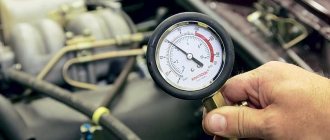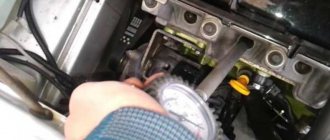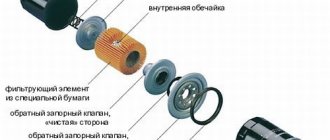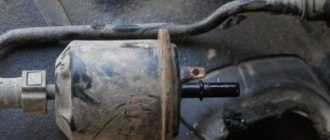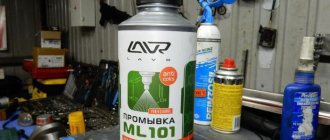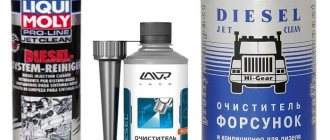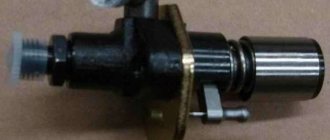01/26/2022 16,591 Intake/exhaust system
Author: Ivan Baranov
One of the features of diesel cars is the use of particulate filters for cleaning exhaust gases. This element of the car cleaning system requires periodic washing. Therefore, we will tell you what a particulate filter cleaner is and how often this element should be washed.
Cleaned particulate filter [ Hide ]
A few words about the design
To better understand the problem, and also to consciously take measures to eliminate it, it is necessary to explain what a particulate filter is. This is a mandatory design element of the exhaust system of a diesel engine, usually installed in front of the muffler. You can see how this is done in the figure below:
The figure shows that this device is a complex tubular structure made of ceramic material, having porous walls between the individual channels. Sometimes the walls are coated with a catalyst. When exhaust gas passes from one channel to another, it is possible to get rid of unburnt fuel particles.
However, with operation, the pores in the ceramics become clogged with these particles, which negatively affects the operation of the diesel engine, and the particulate filter must be cleaned to restore its normal performance.
Exhaust system
During the process of fuel ignition, toxic gases are released in the internal combustion engine, which are removed from the combustion chamber through the timing system and sent to the exhaust line. This system consists of several important elements that not only divert the flow as far as possible from the driver and passengers, but also reduce noise levels and filter gases, trapping harmful particles. This allows you to make a diesel car not only economical, but also environmentally friendly. In terms of the latter parameter, it is practically not inferior to gasoline internal combustion engines.
The particulate filter has been an integral part of the exhaust system since the mid-2000s as a result of the adoption of new regulations on the amount of permissible emissions of harmful substances into the atmosphere. As you can easily guess from the name, this element is designed to trap soot particles that appear during the combustion of diesel fuel. The device is a metal cylinder, inside of which there is a cellular structure made of heat-resistant material. Its effective service life is about 120-150 thousand kilometers, but depends on the fuel used, as well as on the specific car model.
How to clean the particulate filter
In order for its performance to be restored, it is necessary to clean the pores of foreign particles. The car manufacturer provides for a procedure such as regeneration for the particulate filter. She may be:
Passive cleaning
Cleaning the inner surface in this way is quite simple; this is provided for by the design of the filter element itself. The following methods are used:
- Afterburning of unburned fuel particles. To do this, a high temperature is ensured inside the filter (at least six hundred degrees), especially in cases where the engine load is maximum.
- Regeneration using special fuel additives such as urea and EOLYS, which ensure soot combustion at lower temperatures (no more than five hundred degrees).
- Regeneration thanks to a catalytic coating on the inner surface of the ceramic tubes. The use of catalysts and high temperatures leads to oxidation of soot particles (combustion).
Active or forced regeneration
In cases where the tubes become clogged, the power and torque of the engine drop, and the car, roughly speaking, stops moving. The system state is monitored by sensors:
- temperature;
- pressure in the cleaning system;
- air flow.
The particulate filter clogs most quickly in city traffic, as well as when in traffic jams, so this mode is the most harmful for diesel cars. This is due to the fact that with such movement the temperature of the exhaust gases is not high enough to completely burn the soot, so it clogs the pores in the tubes. To restore the car's performance when this happens, it is necessary to burn through the particulate filter.
Active regeneration
Active regeneration of the particulate filter, located close to the manifold, consists of additional fuel injection (post-injection) when the piston is at bottom dead center. Additionally, the throttle valve is closed and the USR valve is closed to reduce the amount of oxygen in the combustion chamber. Unburned fuel enters the catalyst and diesel particulate filter and burns there along with the accumulated soot. A sign of this may be white smoke, as well as increased idle speed, fuel consumption, and most importantly, increased oil level. More precisely, oil diluted with diesel fuel, because... Unburnt fuel flows down the cylinder walls into the crankcase. Therefore, there are not isolated cases of crankshaft liners turning, when the entire engine needs to be “regenerated”.
The same thing happens with the particulate filter, located in a separate “can” quite far from the catalyst. But in this case, a special liquid is also supplied (for example, the Iolis additive), which reacts with soot particles and allows burning to be performed at a lower temperature. The additive is poured into a separate tank and lasts up to 100,000 km. This system is more typical for cars with PSA engines, i.e. Peugeot, Citroen, Ford, Mini, etc.
On VAG cars (Audi, VW, Skoda, Seat, Porsche...), Mercedes, Toyota, etc. no such additive is required. Many people confuse Iolis with AdBlue urea, but the principle of these liquids is different.
Separately, we will say that regeneration is activated only on a working motor, because if there is an error, for example, in the throttle or USR valve, it simply will not start and only a forced start will be possible using a diagnostic scanner.
But as you probably understand, regeneration launched by a diagnostician is no different from regeneration launched by an engine control program. Therefore, when the particulate filter becomes clogged, the diagnostician can only do the same thing that the engine control program has repeatedly done before.
How to burn through a particulate filter
This can be done in the following ways: Directly by the driver, for which it is recommended to periodically drive a distance of about forty kilometers at a speed of eighty kilometers in low gear. In this driving mode, the exhaust gas temperature rises and forced regeneration occurs, during which the functionality of the particulate filter is restored, which is necessary for the normal operation of the machine in the future.
Burning can be automatically performed by the vehicle's engine control controller by:
- injection of special additives into the fuel that contain cerium and increase the temperature of the exhaust gas;
- late fuel injection;
- additional fuel injection during the exhaust stroke, as a result of which its combustion occurs directly in the exhaust system. The exhaust gas temperature rises, soot particles burn and forced regeneration occurs;
- the use of an additional electric heater installed on the particulate filter (its input).
Basic cleaning methods
To reduce the clogging of the particulate filter, manufacturers provide an automatic cleaning function. It's called regeneration. Its essence is to raise the temperature in the device above 500 degrees for a while. In this case, the accumulated soot particles burn out and the filter device is cleaned.
Regeneration is triggered by the engine's electronic control unit by increasing the amount of fuel injected into the combustion chamber. But for this it is necessary that the engine operates at full load. When traveling short distances, when stuck in traffic jams for a long time, in the cold season, the engine simply cannot warm up properly, and regeneration does not start.
Therefore, cleaning the diesel particulate filter can be carried out in other ways:
- Forced regeneration. This method involves accelerating the car to a speed of 80 km/h in a low gear and driving in this way for at least 40 km. With such a load, the temperature of the exhaust gases rises and the soot accumulated in the filter ignites. This procedure can also be carried out in a service station using special equipment.
- Lowering the temperature at which soot ignites. The particulate filter can be cleaned in this way using special additives that are added to the fuel. Additives should be used at an early stage of filter contamination every 2-3 thousand kilometers.
Flushing the diesel particulate filter
To restore normal operation of the engine, you can not only burn out the particulate filter, but also the cleaning procedure can be carried out if washing is carried out. During this operation, a special liquid is used, and the procedure itself depends on the product used:
DPF Flushing Liuquid . In this case, the cleaning procedure is performed as follows:
- the particulate filter is removed from the car and its inlet or outlet is closed;
- the liquid used for cleaning is poured inside so that the entire volume is filled;
- the product to be washed is kept in this state for ten hours, and it must be shaken periodically;
- after this time, you need to rinse everything with warm water;
- install the filter on the car and drive a certain distance to evaluate the washing results.
Cleaning liquid "TUNAP MP 131" . With it, the cleaning procedure is performed slightly differently. The standard pressure or temperature sensor is removed, a probe is inserted into the resulting hole, and liquid is sprayed through it onto the particulate filter several times at intervals of five seconds. Then rinsing is carried out using TUNAP MP 132 concentrate.
As a result of such actions, the soot dissolves and is distributed over the entire surface, as a result of which normal regeneration becomes possible. After installation has been carried out, restoring the system to its original state, normal regeneration is manually started, during which the soot and cleaning liquid accumulated on the internal surface are burned.
Washing and regeneration can be performed using means other than those listed, but the examples given should be sufficient to assess the possibility of cleaning using special preparations.
How to clean a well with your own hands
Such wells are characterized by a shallow depth of 25 meters on average. They use low-power “baby” type pumps. Modernly, as a result of silting or improper operation, the flow rate of water entering the well may decrease.
Let us schematically explain this process
Domestic wells are drilled to the level of sandy or limestone aquifers. The drilled well is deposited with pipes, and a filter is installed in the lower part. For convenience, a caisson or concrete ring is installed on top. A pump suspended on a hose is released into the well, and after turning on, it begins to pump water out of the well. The problem occurs in the lower part; when silting occurs, a plug is formed that prevents the flow of water into the well pipe. The well's flow rate is gradually decreasing and may disappear. But before thinking about a new well, let's try to revive the old one.
First way
The first cleaning method is to manually remove sludge from the pipe. A vibrating pump is often used in such wells. We install a pump with a lower water intake and finalize it. We unscrew the nut on the tip of the pump and install a metal bracket about 15 centimeters long in the center. The nut must be tightened well so that it does not slip down. This design will allow for better mixing of silt at the bottom of the well.
We also connect a hose and a cord to the pump by which we will lift it and release it down. Slowly release the pump and hose to the bottom of the well. The pump is released to its full depth until contamination comes into contact. There should be a certain amount of water in the well, and if there is none, it should be poured.
When water appears in the well, turn on the pump and begin to pump it lightly up and down. The operating pump should be located at the very end of the well, and the fixed bracket stirs up the sludge when rocked. The pump picks up contaminants and throws them out. During the process, the wells were cleaned out; the work may take longer, which indicates that there is a lot of silt at the bottom. However, the result is worth it.
Periodically, it is recommended to pull out the pump and inspect its inlets; if they are clogged, they should be cleaned. With good skill, you can reach the base of the filter in a few days and clean out all the small deposits. During one day of work, we managed to remove several buckets of sand, rust and small stones.
Second way
For severe cases when the pipe space becomes clogged, we try the second method for cleaning the well. To do this, additional resources and forces should be attracted. The resulting shell of sedimentary rocks will be destroyed using pressure. A fire hose from a fire truck is suitable for this.
We release a fire hose of the required diameter to the bottom of the well. Finally, a special tapering tip is installed on the sleeve. The narrowed design increases the pressure at the bottom of the well. The tip of the hose must be lowered to the very bottom and supply water under pressure from 6 to 12 atmospheres.
The washing technique is as follows
At first, under slight pressure, water enters the sleeve, and then the well itself is filled. As soon as the well is filled with water, we sharply increase the water pressure. Thus, the column of water in the well creates a hydraulic seal and, under high pressure, water begins to penetrate through the filter beyond the pipe space. and destroys the sediment shell on the filter.
As the pressure increases, contaminants from the pipe and filter will begin to come out to the surface. When the caisson or concrete ring is completely filled with water, it should be pumped out. Contamination that has come to the surface allows the fire hose to be lowered even lower. We continue flushing and, like the first time, start slowly, filling the sleeve with water, and then under high pressure creates a water hammer below. And we see how the pollution from the pipe comes to the surface again. Having removed the dirty water from the caisson, we notice sediments of small stones and sand at the bottom.
Immediately after flushing, it is necessary to begin pumping water from the well. At first, the water may be cloudy, but it is constantly pumped out, taking short breaks. We hope you liked this video tutorial on how to clean a well with your own hands and you were able to clean the well.
I like it I don't like it
About cleaning options
Unfortunately, no matter what cleaning options are used, they are not unlimited. The particulate filter is replaced after its operation with a mileage of no more than 180 thousand kilometers. And since the product is quite expensive, it is worth taking some measures to postpone this procedure.
Premature wear is largely influenced by driving conditions, driving style, and most importantly, fuel quality. If all of these conditions are severe for the vehicle, then replacement may be required much sooner.
Cleaning issues, as well as regeneration, must be under the constant control of the driver. They have a direct impact on the technical condition of the machine and ensure its normal operation. » alt=»»>
The appearance of the diesel engine on the mass consumer market forced the developers of such engines to bring them to global environmental standards. Diesel engines must effectively combat exhaust gases, trapping elements that are dangerous to be released into the atmosphere. During the modernization of the exhaust gas system of diesel engines, DPF particulate filters began to be installed everywhere, which effectively clean the exhaust. During operation of a diesel engine, the particulate filter becomes dirty and requires cleaning or replacement.
What is a DPF particulate filter: task and principle of operation
As the name suggests, the job of a particulate filter is to retain soot particles as they appear in the exhaust. Soot accumulates in it, which is then burned, thereby achieving an exhaust that is less harmful to the environment.
The operating principle of the DPF filter is as follows:
- Soot accumulates in the filter until a critical moment, which depends on the difference in pressure before and after the filter element;
- When this pressure deviates from the norm, that is, the filter capacity decreases, the engine electronic control unit receives information about this and activates the afterburning mode of the accumulated soot; Please note: Depending on the engine manufacturer, the afterburning process may be activated under different conditions.
- The afterburning process occurs at an increased crankshaft speed and increased fuel injection, the command for which is supplied by the control unit;
- This increases the temperature of the exhaust gases to values at which soot burns out.
Despite the presence of a soot burnout mode, it can nevertheless accumulate in the DPF filter and not burn out. This is especially true for drivers who rarely operate the car at high speeds, driving mainly in urban areas.
Since the cost of the DPF particulate filter is quite high, drivers need to monitor these elements and clean them in a timely manner so as not to face the need for replacement.
Questions and answers
Why is interrupted self-cleaning dangerous?
In a single version - nothing. If the process takes a natural turn, then soon you will have to change the oil and force active regeneration. If you go to extremes, then one day the engine will stall and will not start.
How long do you need to drive to burn through the particulate filter?
Usually 50-70 km is enough. Sometimes even less. The best guide is not kilometers, but an extinguished lamp, if we are talking about pre-emergency mode, or the cessation of the emission of thick white smoke from the exhaust.
Burning or flushing: what to do in an emergency
Of course, not a single chemical comes close to standard soot burning products. Experienced drivers generally believe that this is money down the drain.
How many grams of soot are allowed for a diesel engine?
We are talking about an electronic counter that calculates the theoretical mass of solid particles inside the filter. There is no single standard; each car has its own threshold. We will use the Audi Q7 as an example, where:
- 40 g – active regeneration is necessary.
- 68 is the limit, upon reaching which even forced burning will not start.
- 56 g – the value at which forced burning ends.
It makes sense to reset the readings only after washing or replacing. The system cannot be fooled simply because the particulate particle counter is not the only value it is guided by, and a clogged particulate filter is not only an electronic limitation, but also a physical one (it is difficult for gases to escape).
Frequent burnouts after refueling at a gas station
There is only one reason for this: low-grade fuel with a high sulfur content. Dilute the remainder with high-quality diesel fuel and the symptoms will go away. Since this often happens on the way to vacation, find out in advance which gas station has the best diesel fuel in a particular region. In the reference article, we looked at decent options on a popular summer destination – the M4 highway.
What happens if you remove the cleaner from the exhaust system?
The diesel will smoke, 20-30 hp will be added, and the ride will become more dynamic. The damage is only caused to the environment. We hasten to warn you that the removal must be carried out competently - with flashing of the on-board electronics.
Why does the particulate filter get dirty quickly?
This unit especially does not like it when the engine operates in excessive fuel consumption mode. This definition includes all city trips, warming up at idle and driving at low speeds.
Carry out passive burning more often, refuel with high-quality fuel, pour oil for diesel engines with low ash content, and then the “soot” will not remind itself for a long time.
Causes of a clogged diesel particulate filter
Soot is a by-product of diesel fuel spent in engine cylinders. In exhaust gases it is presented in the consistency of a fine powder, which is retained almost completely by the particulate filter mesh.
During the operating cycle, hydrocarbon particles do not burn in the chamber and go into the exhaust. Because of them, resinous deposits begin to form. This resin glues small soot particles together, which leads to the formation of carbon deposits. Along with soot, this carbon deposit also contains other elements of combustion of diesel fuel, as well as metal sulfates that appear in the exhaust due to the combustion of oil trapped in the cylinder.
Please note: Metal sulfates are a product of the combustion of fuel additives containing metal elements. There are especially many metal-containing additives in universal oils, which can be used for diesel and gasoline engines. This is one of the reasons why such oils are not recommended for regular use in diesel engines.
The result of the processes described above is the formation of soot deposits with particles of other elements that settle on the filter and do not burn out in the soot combustion mode.
Principle of operation
The purpose of a particulate filter is to prevent/minimize the release of soot into the atmosphere. It is part of the muffler and its main task is to clean exhaust gases. However, you should not compare this device with a catalyst, because the catalytic converter fights exhaust gases, while the filter only fights soot in them.
The particulate filter operates in two stages:
Stage I – soot capture. At this stage, soot particles settle on the walls of the filter element, which resemble cells in appearance. At the same time, the soot does not remain here completely, but only particles larger than 0.5 microns in size. The rest of the “trifles” come out together with gases, although the percentage of such precipitation is small - about 10%.
Stage II: regeneration. A labor-intensive process of cleaning the cells of the filter element from soot deposits. The procedure takes place according to the regulations prescribed by the manufacturer.
Interaction with the catalytic converter
On a diesel engine (compared to a gasoline engine), for the most part, a catalyst is not used due to differences in engine ignition systems (no spark plugs). But large automobile concerns (VW Group) are actively working in this direction and creating combined particulate filter/catalytic converter circuits.
Combined filter design:
- The sides of the cleaning device body consist of a catalytic material (often titanium). Through this, combustion and oxidation processes of exhaust gases (carbon monoxide, carbon dioxide) occur;
- the internal cells have small cross-section channels (consisting of silicon carbide) that do not allow soot particles to enter the atmosphere.
Passive regeneration
This occurs only on a combined device, where the catalytic converter provokes the purification process through high temperatures. The particulate filter is heated to 300-500 O C, at which soot elements oxidize and burn.
This happens as follows:
- In the catalytic converter, nitrogen and oxygen form a chemical reaction. The result of the interaction is the formation of nitrogen dioxide.
- Nitrogen dioxide reacts with soot to produce carbon monoxide/nitric oxide.
- Final stage: oxygen forms a chemical reaction with nitric oxide/carbon monoxide. Carbon dioxide and nitrogen dioxide appear.
This is how the particulate filter can be cleaned, but only on long trips.
The cleaning procedure is carried out while driving at high engine speeds. In this way, it is possible to achieve heating of the filtration element to approximately 600 O C. At this temperature, a process of chemical reactions similar to that described above takes place, followed by cleaning of the cells.
All the driver needs to do during forced regeneration is to maintain the required engine speed. Everything else happens under the supervision of an electronic system - information is read from sensors:
- air;
- exhaust gas temperature sensors;
- pressure sensors that the particulate filter has.
At the end of the cleaning procedure, the pressure returns to its original values, which indicates the completion of regeneration.
Filter without catalytic converter and automatic regeneration
The particulate filter may not be compatible with the catalyst. The catalytic converter is then located in front of the filtration element, and the two devices do not come into contact in any way. A similar scheme is used by Ford, Peugeot, Toyota and others.
Here the purification process takes place differently. At a certain mileage (with an exact frequency of several hundred kilometers), the car’s electronics independently inject a special additive (based on Cerium) into the heavy fuel:
- When the diesel particulate filter becomes clogged, the injection system supplies this additive to the combustion chambers. When exhaust gases exit, the filter element inside heats up to very high temperatures (from +650 to +750О C), which heats up the device;
- cerium does not interact with the fuel and passes along with the exhaust gases into the filtration device. The moment the substance comes into contact with the filter (mesh), it ignites and raises the temperature to +900-1000 O C;
- soot particles oxidize and burn.
This temperature regime promotes the regeneration of the filter element. The exhaust tract remains undamaged thanks to the use of high-strength materials.
A special container is provided for the fuel additive. The additive itself is designed for 100,000 kilometers, although this figure may be reduced when the vehicle is operated on low-quality fuel.
What determines the service life of a particulate filter?
Depending on how carefully the car owner approaches the issue of clogging of the particulate filter, the service life of the element is directly correlated. The service life is also affected by the number of activation modes of soot combustion. The more often the car engine activates the soot burning mode, the less the particulate filter will last.
To increase the service life of the particulate filter, experts recommend, especially if a car with a diesel engine is operated within the city, to clean this element at every service. It is especially important to do this if there are problems with the engine, which can lead to the formation of massive carbon deposits on the filter element.
Please note: A clean particulate filter is also effective from an economic point of view. If the filter is dirty, engine power is reduced, which increases engine consumption to drive the car with the same dynamics.
It is possible to increase the service life of the particulate filter if you use special additives for diesel fuel. In automobile stores you can find additives that are aimed at reducing the amount of carbon deposits formed as a result of engine operation. This is achieved due to maximum combustion of fuel in the engine cylinders, which leads to a reduction in the amount of soot in the exhaust gases. It is recommended to use this additive at least once every 3,000 kilometers of the vehicle.
Also, the process of soot formation on the particulate filter is greatly influenced by the quality of the fuel used, so you need to refuel with high-quality diesel in order to maximize the service life of this element.
How to clean the DPF
There are two main ways to clean the DPF from carbon deposits. The first implies the need to remove the filter element from the car, and the second involves performing actions directly on the car. Both methods have their advantages and disadvantages, so we will consider them separately.
Cleaning the particulate filter with removal
The complexity of this method lies in the need to dismantle the diesel particulate filter, as well as the duration of the procedure. On average, it will take about 8 hours to clean the filter.
For cleaning, special particulate filter flushing fluids are used, which can be purchased at automotive stores. It is better to choose formulations from proven brands such as Luffe, Pro-tec, Liqui Moly and the like. These liquids are compositions of petroleum components and various additives that can dissolve soot deposits. Liquids are supplied in 5-liter canisters; on average, the entire canister will be required for one flush. Canisters may have a place on top to attach a hose, some of them have a hose included. The hose makes it easier to fill the particulate filter with flushing liquid.
The housing of the removed particulate filter must be completely filled with washing liquid and left for the time specified in the instructions for use of the composition (about 8 hours). After this, it is enough to rinse the filter with a stream of water to remove any remaining dirt, as well as any remaining cleaning agent.
Please note: Flushing with water must be taken seriously as the cleaning agent is flammable and can ignite if exhaust gases enter.
After washing the particulate filter with water, all that remains is to dry it and install it in place.
Cleaning the particulate filter without removing it
The method of washing the particulate filter without removing it is faster, since the work is carried out directly on the car. The design features of the filter make it possible to supply cleaning liquid through the hole for installing a pressure or temperature sensor, having previously removed them.
It is important to note that a different composition is used to clean the particulate filter without removing it. This is due to the fact that the work is carried out directly on the car, and there is no way to ensure that petroleum products will be completely removed from the particulate filter. Therefore, a water-alkaline based composition is used for cleaning. with washing liquid. The liquid will allow the remaining alkali to be neutralized after cleaning.
To wash the particulate filter without removing it, you will need to get a spray gun.
Please note: You can also initially find cleaning fluids in aerosol cans. To effectively use the liquid in the can, be sure to read the instructions for it.
Before washing the particulate filter, the car engine must be warmed up, after which it is necessary to wait until the temperature in the filter element reaches about 40 degrees Celsius. This must be done to increase the efficiency of the alkaline composition.
The composition is sprayed onto the particulate filter under a pressure of about 8 bar. In this case, the spraying process should be interval: the liquid is injected for 10 seconds, then you need to wait 10 seconds before injecting a new dose. This will require about 1 liter of cleaning fluid. It is also important to rotate and move the spray probe to clean the entire particulate filter. After washing with an alkaline composition is carried out, clean water is sprayed in the same way.
After completing work on cleaning the particulate filter with liquid agents, it is recommended to carry out the procedure for burning off the remaining soot by operating the vehicle at high speeds for 20-30 minutes.
Second way
Washing the filter unit directly on the car
This method allows you to clean the filter without removing it from the car. With this method, manufacturers of cleaning products take into account the possibility of ignition of the composition of the washing liquid. Therefore, solutions with a water-alkaline base are used for washing. They are used in tandem with a flushing mixture that can neutralize alkali after the cleaning process is completed.
For this procedure the following are used:
- set of liquids;
- gun;
- spray;
- probes.
All these elements are sold in a car store or on the market. Allows you to clean the filtration element on any model of diesel car equipped with a particulate filter device. Cleaning is carried out by step-by-step dosing of the incoming cleaner through the hole for the pressure and temperature measurement sensor. Before starting the procedure, the car is warmed up, after which the filter device is allowed to cool to a temperature of 400C. This is the optimal temperature indicator for the effective operation of the alkaline mixture.
To rinse the filtration device, you will need a spray gun; it must be connected to a probe, which will be inserted into the sensor hole. The cleaning agent is sprayed inside the filter, then left for up to 10 seconds. and spray again intermittently. This procedure is repeated several times. To increase the cleaning efficiency of the probe, it is necessary to perform rotational movements around its axis. Then a rinsing agent is used, a second probe is used, and the procedure is repeated in the same way, maintaining a time interval. The result of these manipulations will be a uniform distribution of soot over the surface of the matrix, and it will be possible to burn it out more efficiently.
After the cleaning work is completed, the sensor is installed in its original place, the car engine is started and the car is operated for 20 minutes at medium and high speeds, then regeneration starts or this procedure begins in automatic mode.

